The ECS Z270H4-I Durathon 2 Mini ITX Motherboard Review
by E. Fylladitakis on September 5, 2017 10:30 AM ESTCPU Performance, Short Form
For our motherboard reviews, we use our short form testing method. These tests usually focus on if a motherboard is using MultiCore Turbo (the feature used to have a maximum turbo on at all times, giving a frequency advantage), or if there are slight gains to be had from tweaking the firmware. We leave the BIOS settings at default and memory at JEDEC (DDR4-2133 C15) for these tests, making it very easy to see which motherboards have MCT enabled by default.
Video Conversion – Handbrake v0.9.9: link
Handbrake is a media conversion tool that was initially designed to help DVD ISOs and Video CDs into more common video formats. For HandBrake, we take two videos (a 2h20 640x266 DVD rip and a 10min double UHD 3840x4320 animation short) and convert them to x264 format in an MP4 container. Results are given in terms of the frames per second processed, and HandBrake uses as many threads as possible.
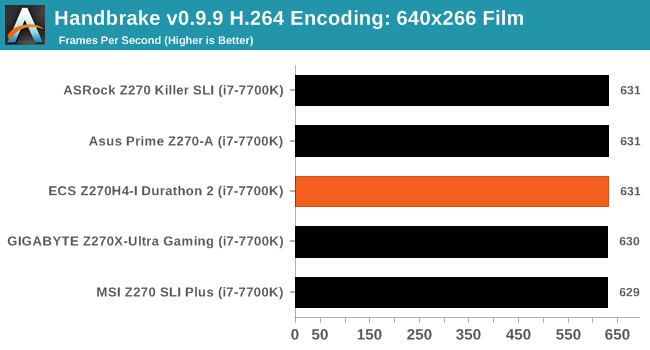
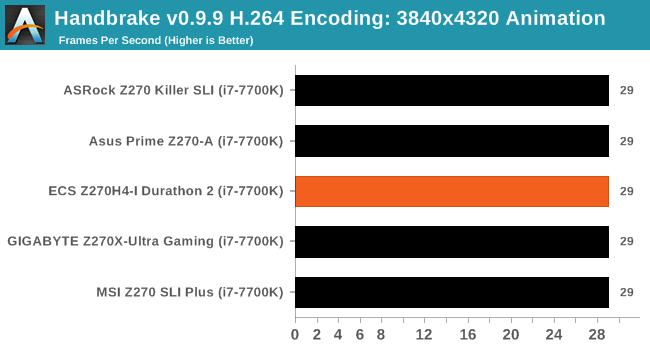
Compression – WinRAR 5.0.1: link
Our WinRAR test from 2013 is updated to the latest version of WinRAR at the start of 2014. We compress a set of 2867 files across 320 folders totaling 1.52 GB in size – 95% of these files are small typical website files, and the rest (90% of the size) are small 30-second 720p videos.
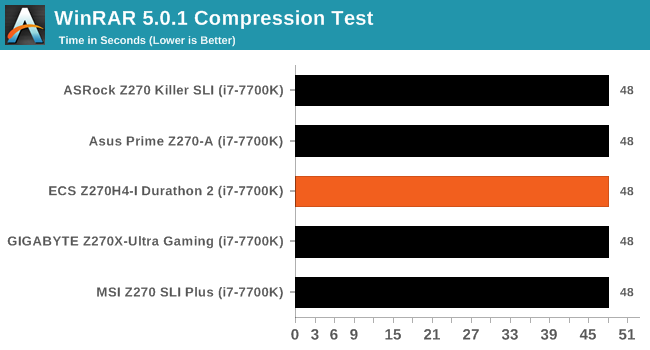
Point Calculations – 3D Movement Algorithm Test: link
3DPM is a self-penned benchmark, taking basic 3D movement algorithms used in Brownian Motion simulations and testing them for speed. High floating point performance, MHz, and IPC win in the single thread version, whereas the multithread version has to handle the threads and loves more cores. For a brief explanation of the platform agnostic coding behind this benchmark, see my forum post here.
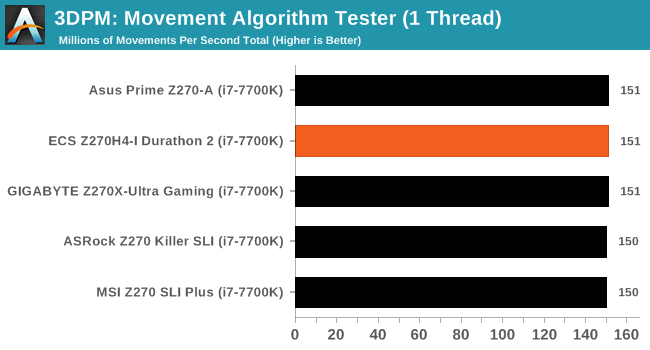
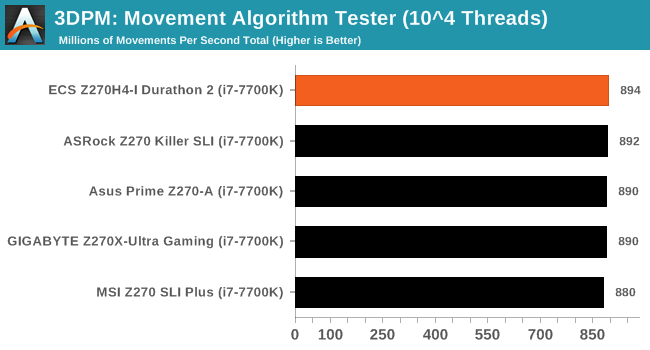
Rendering – POV-Ray 3.7: link
The Persistence of Vision Ray Tracer, or POV-Ray, is a freeware package for as the name suggests, ray tracing. It is a pure renderer, rather than modeling software, but the latest beta version contains a handy benchmark for stressing all processing threads on a platform. We have been using this test in motherboard reviews to test memory stability at various CPU speeds to good effect – if it passes the test, the IMC in the CPU is stable for a given CPU speed. As a CPU test, it runs for approximately 2-3 minutes on high-end platforms.
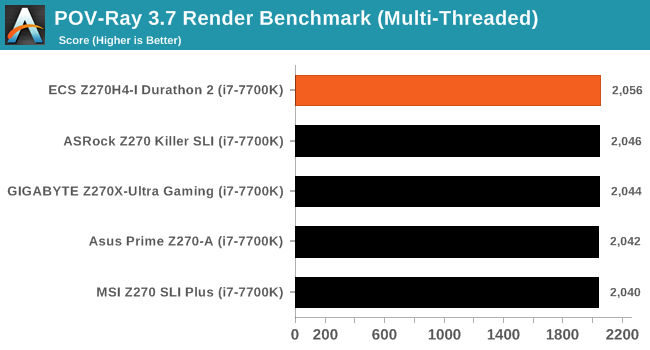
Synthetic – 7-Zip 9.2: link
As an open source compression tool, 7-Zip is a popular tool for making sets of files easier to handle and transfer. The software offers up its own benchmark, to which we report the result.











19 Comments
View All Comments
jabbadap - Tuesday, September 5, 2017 - link
Erhm Your spec table says "Onboard M.2 none", yet there is one m.2 slot behind the motherboard if I'm not mistaken.Interesting little guy, though I would not OC with that tiny vrm heatsinks it has.
Ryan Smith - Tuesday, September 5, 2017 - link
Thanks!(There are actually 2, one on top and one on the underside of the board)
jtd871 - Tuesday, September 5, 2017 - link
Thanks for the review.The lustre on the 200-series is wearing a bit thin, however, with Intel wooing consumers with the next-gen CPUs and chipset, so I'm not surprised to see some manufacturers trying to drum up a bit of business to move some inventory.
I've always been a bit confused as to why motherboard manufacturers appear to cheap out on their mITX offerings (since mATX and mITX would seem to be better suited to the capabilities of the Z-series chipsets with the inherent limitations on PCI lanes than full ATX or E-ATX boards).
Notes to mobo manufacturers and designers, here are some ideas on how to differentiate your product to consumers (other than price):
1) Don't cheap out on the audio codec. Use the latest and greatest.
2) If you're offering a Z-series chipset, include the power phases and connectors requires to overclock the top-of the line CPU SKU for the chipset, and choose heatsinks based on performance rather than looks.
3) Consider dropping the number of SATA connections to 2: mITX systems generally don't run more than 2 SATA drives, and many these days just run a NVMe drive. Of the SATA connections you do offer, make them RAID-able. Use the freed-up HSIO lanes for more the latest I/O connectors.
4) Especially for mITX, use the physically smallest I/O connectors practical and locate them, or at least 1 of each type, where a full-length PCIe card won't obstruct them.
5) Include diagnostic LEDs (or even a separate diagnostic PCB that connects to a header on your board?) (to save space).
6) Shamelessly copy (and, by all means, improve on) the best and most innovative features of your competitors' boards and BIOS.
7) Read your product's reviews. Especially the critical ones.
Brianmmm - Monday, September 18, 2017 - link
Maybe you're thinking of something like this? I have one, it rocks.http://www.anandtech.com/show/9854/asus-maximus-vi...
nathanddrews - Tuesday, September 5, 2017 - link
I got really excited when I saw "Durathon" because I thought it was some new AMD chip I didn't know about.MajGenRelativity - Tuesday, September 5, 2017 - link
Return of the Duron?artk2219 - Tuesday, September 5, 2017 - link
You joke but i'd love to see that. Maybe name the new Raven Ridge APU's with failed GPU's Durons instead of athlons? Probably not, since sempron took Durons place, but i wouldnt mind it :).BrokenCrayons - Tuesday, September 5, 2017 - link
Eh, I know it's interesting and sometimes fun to overclock, but the performance benefit is typically insignificant without water cooling or a very large air cooler. Both of those cooling setups demand physical space so they increase the size of the system and that takes away some of the point in getting a Mini-ITX motherboard in the first place. ECS might be touting it as a feature, but I can't see it being a key selling point to even the small form factor gamer audience targeted by this motherboard. It probably doesn't matter much that its a rather limited capability of the board.DanNeely - Tuesday, September 5, 2017 - link
As I've observed before, the MITX mobo form factor is trying to serve two masters with different needs, desires, and general system configurations.The first - and who the form factor was originally created for - are people who want as small of a system as possible (but who don't find the NUC/etc compelling for whatever reason). For these people, you're right that any OC feature is likely to be unused. However they're not who it's being intended for.
The second group of people building mITX are conventional gamers who've decided that other than a single GPU they have zero need of PCIe expansion slots, and thus no need for a larger mATX/ATX motherboard. They're still building conventional gamer type systems with a large enough PSU and sufficient cooling to consider an OC because they're using cases only a few inches smaller than what would be normal with an mATX build.
btmedic04 - Wednesday, September 6, 2017 - link
Im surprised ECS is still around. I haven't used one of their products since the G45/intel pentium dual core system I put together for my dad way back when.As for the overclocking options, I could see them possibly being useful in an undervolting/underclocking scenario (say a passive build) or paired with a pentium g3258-like processor (please intel! the i3 7350k is overpriced for what it is)